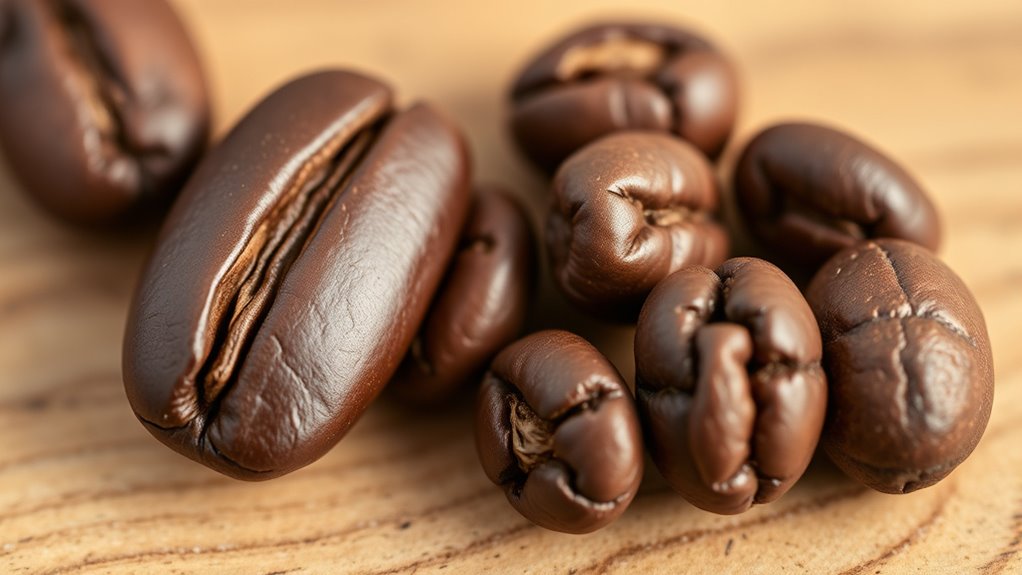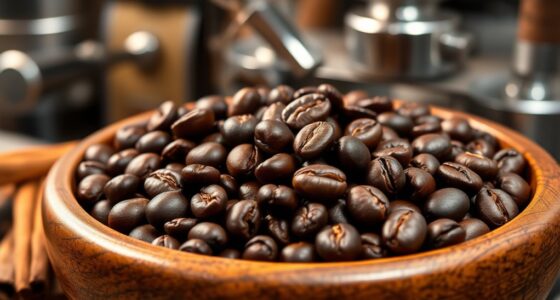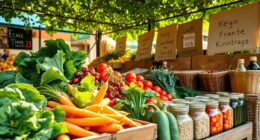Arabica and Robusta differ mainly in flavor, caffeine, and growing conditions. Arabica offers a sweeter, smoother taste with fruity and caramel notes, while Robusta has a stronger, earthier, and more bitter flavor. Robusta contains nearly double the caffeine of Arabica, making it more stimulating. It’s easier to grow in hotter, lower elevations, whereas Arabica prefers cooler, higher altitudes. Want to discover more about how these differences shape your coffee experience? Keep exploring!
Key Takeaways
- Arabica beans are sweeter, more complex, and have fruity and caramel notes, while Robusta beans are stronger, harsher, and often bitter.
- Arabica contains about 60% more lipids and twice the sugar of Robusta, leading to smoother flavor and better aroma retention.
- Robusta has approximately 2.7% caffeine, nearly double Arabica’s 1.5%, resulting in a more stimulating but bitter taste.
- Arabica beans are oval with a curved split line, producing smoother grinds; Robusta beans are rounder with a straight split line.
- Arabica grows at higher elevations in cooler climates and is more expensive; Robusta thrives at lower elevations, is easier to cultivate, and is cheaper.

When choosing between Arabica and Robusta coffee, understanding their key differences can help you find the flavor and strength you prefer. Arabica beans tend to have a sweeter, more complex flavor profile with fruity and zesty notes. You might notice hints of caramel and berries, making each cup smooth and enjoyable.
Choosing Arabica or Robusta depends on your preferred flavor and strength in every cup.
In contrast, Robusta offers a much stronger, harsher taste, often described as bitter or earthy, with some people comparing it to burnt rubber. If you prefer a bold, intense flavor, Robusta could be your go-to.
The difference in taste largely comes down to their lipid and sugar content—Arabica contains about 60% more lipids, which contributes to a smoother, richer mouthfeel, and it also has twice the sugar of Robusta. This makes Arabica generally more refined and less bitter, especially when roasted well.
Caffeine levels also differ remarkably. Arabica has about 1.5% caffeine, while Robusta packs nearly double that at around 2.7%. The higher caffeine content in Robusta not only makes it more stimulating but also adds to its bitterness.
That extra caffeine acts as a natural pesticide, helping Robusta plants resist pests and diseases better than Arabica. Because of its strong flavor and higher caffeine, Robusta is often used in energizing blends or instant coffee.
If you’re after a more robust, punchy wake-up call, Robusta’s higher caffeine content serves that purpose well.
When you look at the beans themselves, Arabica beans are oval and flat with an oily surface, featuring a curved split line. Robusta beans are rounder, smaller, and have a straighter split line.
This physical difference influences how each bean behaves during grinding and roasting. Arabica tends to produce smoother grinds and higher-quality flavor development because its oils help retain aroma.
Robusta beans are often grainier when ground, which can impact the texture of your brew. The durability of Robusta beans also makes them better suited for espresso, as they produce a thicker crema that holds up during extraction.
Growing conditions play a role too. Arabica plants thrive at higher altitudes, around 3,000 to 6,000 feet, in cooler, more stable climates. Robusta plants grow in lower elevations and tolerate hotter, more humid environments, making them easier to cultivate in regions with challenging climates.
They also produce higher yields and resist pests and diseases more effectively, which explains their prevalence in Africa and Asia. Because of these factors, Arabica is often associated with Latin America, while Robusta dominates in regions with harsher growing conditions.
Price and market usage also differ. Arabica is generally more expensive due to its lower yields and higher demand for premium, specialty coffees. Robusta is cheaper, making it popular for blending and instant coffee because it’s cost-effective.
Its higher chlorogenic acid content contributes to bitterness but also offers potential health benefits as an antioxidant. Overall, Arabica is favored for its complex flavors and acidity, appealing to coffee connoisseurs, while Robusta’s strength and affordability make it essential in many commercial blends.
Frequently Asked Questions
Which Coffee Species Has a Higher Caffeine Content?
You’re asking which coffee species has more caffeine. Robusta has a higher caffeine content, with about 2.7% compared to Arabica’s 1.5%.
This means Robusta provides a stronger caffeine kick in your cup, making it popular for those seeking a quick boost. It also contributes to a more bitter taste.
How Do Climate Conditions Affect Arabica and Robusta Growth?
Imagine you’re in the 19th century, witnessing how climate shapes coffee growth. You’d see that Arabica thrives in mild, stable conditions but struggles with rising temperatures, droughts, and disease.
Robusta, however, adapts better to warmer, variable climates thanks to its resilience and genetic diversity. Climate change threatens both, but Robusta’s flexibility might help it withstand harsher conditions, making it a crucial option for coffee cultivation’s future.
Are There Health Benefits Associated With Each Coffee Type?
You can enjoy health benefits from both coffee types. Arabica offers antioxidants, essential minerals, and a moderate caffeine boost, supporting heart health and reducing inflammation.
Robusta provides a higher caffeine content for alertness but has fewer antioxidants and nutrients.
Consuming either in moderation helps maximize benefits like improved focus and metabolic support, while avoiding side effects like jitters or disrupted sleep.
Your individual tolerance guides the best choice for you.
Can Arabica or Robusta Be Organic or Pesticide-Free?
You can definitely find both Arabica and Robusta coffees that are organic or pesticide-free. Organic Arabica is more common because of its complex flavor and growing conditions.
While organic Robusta exists, it is less widespread. Pesticide-free options are available for both types, offering healthier choices with fewer synthetic chemicals.
Keep an eye out for certifications, so you’re sure you’re getting coffee that aligns with your preferences for sustainability and health.
What Are the Best Brewing Methods for Each Coffee Type?
They say “the proof of the pudding is in the eating,” and the same applies to coffee brewing. For Arabica, you’ll want pour-over, AeroPress, or Chemex to highlight its delicate, nuanced flavors and bright acidity.
For Robusta, use espresso, Turkish, or cold brew to enhance its bold, full-bodied profile. Each method reveals the unique qualities of these beans, ensuring you enjoy their best characteristics.
Conclusion
So, while both Arabica and Robusta have their unique charms, choosing between them is like selecting your perfect coffee partner—each brings something special to the table. You might find yourself gently leaning toward one, but don’t dismiss the other just yet. Sometimes, blending the two creates a delightful harmony you never expected. Keep exploring, and you’ll discover your ideal brew, turning every cup into a subtly enchanting experience you’ll want to savor again and again.









